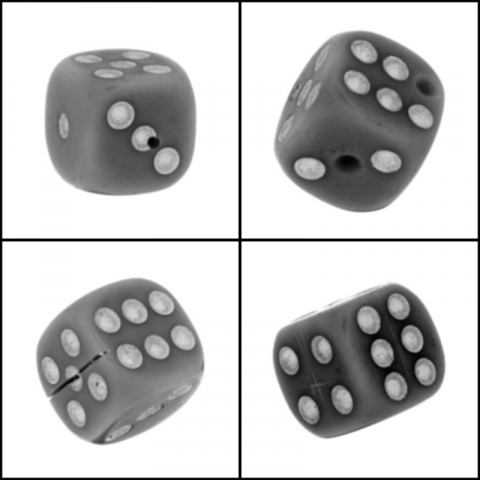Datasets
Open Access
Two-Perspective Dices Dataset for Anomaly Detection
- Citation Author(s):
- Submitted by:
- Peter Jakob
- Last updated:
- Wed, 05/05/2021 - 08:17
- DOI:
- 10.21227/vgrg-d823
- Data Format:
- License:
 329 Views
329 Views- Categories:
- Keywords:
Abstract
Arbitrarily falling dices were photographed individually and monochromatically inside an Ulbricht sphere from two fixed perspectives. Overall, 11 dices with edge size 16 mm were used for 2133 falling experiments repeatedly. 5 of these dices were modified manually to have the following anomalies: drilled holes, missing dots, sawing gaps and scratches. All pictures in the uploaded pickle containers have a resolution of 400 times 400 pixels with normalized grey scale floating point values of 0 (black) through 1 (white).
The datasets contain files for training (“x_training.pickle”, w/o anomalies) and testing (“x_test.pickle”, w/ and w/o anomalies). Labels were saved in “y_test.pickle” whereas label zero correspond to non-anomalous data. Because the pose of the falling dice was not constrained the two fixed perspectives had the chance to see anomalies at all in 60 out of 100 experiments. Hence the test dataset contains 60 anomalous samples. Furthermore, data is augmented w.r.t. erased patches, changes in image constituents like brightness, and altered geometry like flipping and rotating.
The shapes of the pickles are
- w/o augmentation, x_train.pickle: (2000, 2, 400, 400)
- w/o augmentation, x_test.pickle: (133, 2, 400, 400)
- w/o augmentation, y_test.pickle: (133,)
- w/ augmentation, x_train.pickle: (4000, 2, 400, 400)
- w/ augmentation, x_test.pickle: (133, 2, 400, 400)
- w/ augmentation, y_test.pickle: (133,)
Dataset Files
LOGIN TO ACCESS DATASET FILESOpen Access dataset files are accessible to all logged in users. Don't have a login? Create a free IEEE account. IEEE Membership is not required.
Documentation
| Attachment | Size |
|---|---|
| 1.55 KB |






